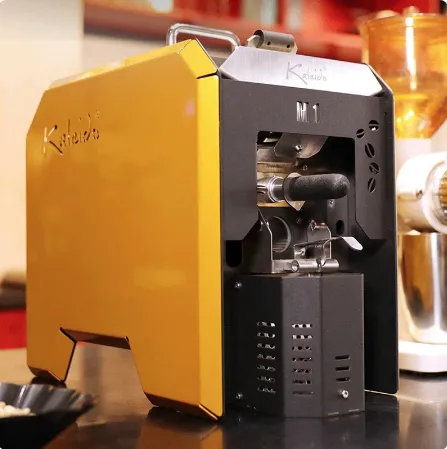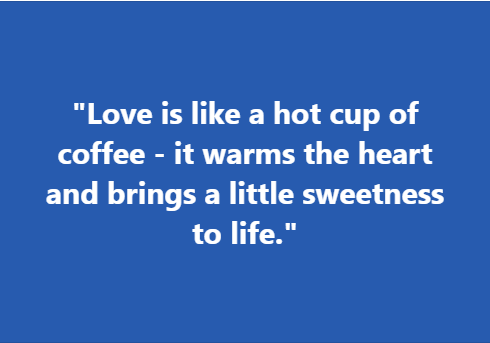Discover the secrets of coffee roasting – learn what you need to know to make the perfect brew. From choosing beans, to roast profiles and more!
Table of Contents
Coffee roasting is a crucial part of the coffee-making process, and it’s important for coffee drinkers to understand what goes into the roasting process.
Roasting is essentially taking raw green beans and transforming them into flavorful, aromatic coffee beans that are ready to be brewed.
Different roasts will bring out different flavors and aromas in your cup of coffee due to the different temperatures used in the roasting process as well as how long they are roasted.
Coffee Roasting Basics
Coffee roasting is the process of transforming green coffee beans into the aromatic and flavorful brown beans we use to make our morning cup of joe.
The roasting process is a crucial step in determining the taste, aroma, and overall quality of your coffee.
There are several things you should know about coffee roasting to ensure that you get the best possible flavor from your beans.
One important factor to consider when roasting coffee is the temperature at which it’s roasted.
Coffee beans are typically roasted at temperatures ranging from 350°F to 450°F. The longer they’re roasted, the darker and more bitter they become.
Another important factor is the type of roast you choose, whether light, medium, or dark roast. Each roast level has its unique flavor profile and characteristics.
Additionally, it’s essential to understand that different regions produce different types of coffee with various flavors and aromas.
Roasters must also consider factors such as moisture content, density, and size when choosing how long to roast their coffee beans for optimal results.
By understanding these basics of coffee roasting, you can elevate your morning brews by experimenting with different roast levels and bean origins until you find your perfect cup!
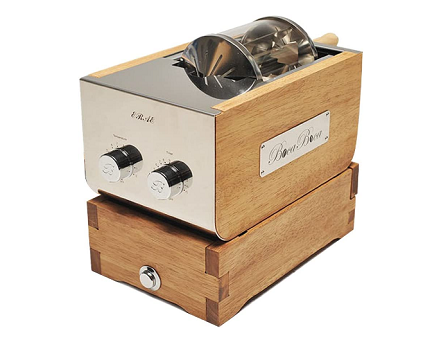
BOCABOCA Coffee Bean Roaster 250 Home Roasting Machine with Cooler Nuts Barista Home Kitchen Cafe 110V & English Guide
Bean Selection
When it comes to coffee roasting, bean selection is a crucial factor that determines the final flavor and aroma of your cup of coffee.
As a general rule, the quality of the beans you use will significantly affect the outcome of your roast.
The first step in bean selection is to choose beans that have been grown in optimal conditions such as altitude and soil type.
For instance, high-altitude Arabica beans tend to be more flavorful and aromatic than low-altitude Robusta varieties.
Another critical aspect when selecting beans for roasting is their origin.
Coffees from different regions possess distinct flavors and aromas based on factors such as climate, soil type, rainfall patterns, and processing methods.
Therefore, understanding these regional differences will enable you to select beans with flavors that match your preferences or those of your clientele.
The size and shape of the beans are other important factors to consider when selecting coffee for roasting.
Smaller-sized or unevenly shaped beans tend to roast at different rates, leading to an inconsistent final product.
On the other hand, denser or larger-sized beans might require longer roasting times but result in richer flavors due to their higher concentration of oils and sugars.
By taking into account these factors during bean selection for coffee roasting, you can enhance the quality of your brews significantly.
Roasting Levels
Roasting coffee is an art that involves heating raw beans to a specific temperature and duration.
It’s what gives coffee its unique taste, aroma, and color.
Roasters categorize different roasting levels based on the amount of time they expose the beans to heat.
Light roasts are roasted for a shorter period, resulting in light brown coffee with no oil on its surface.
They have a high acidity level, fruity flavors, and floral aroma. Light roasts also retain more caffeine compared to darker roasts.
A medium roast takes slightly longer than a light roast but is still lighter than a dark roast.
The beans turn medium brown color with some oils visible on the surface.
Medium-roasted coffee has balanced acidity and sweetness with chocolate notes.
Dark roast is roasted for the longest duration until the beans turn dark or black in color with an oily surface.
Dark-roasted coffee has low acidity levels, smoky flavors, and bitterness with a full body that feels heavy on the tongue.
Knowing about different roasting levels helps you choose your preferred cup of coffee based on your flavor preferences and caffeine tolerance level.

Home Distilling: A Complete Guide for Making Your Liquor At Home, With Complete Process, And Recipes Paperback – February 1, 2023
Roasting Process
The roasting process is where coffee beans undergo a transformation from green to brown, and their flavors and aromas are brought to life.
During the roasting process, the temperature of the beans increases, causing chemical reactions that create complex flavors and aromas.
The duration and intensity of the roasting process determine whether the coffee will have a light or dark roast profile.
The first stage of the roasting process is called drying. During this stage, moisture is driven out of the bean by exposing it to high heat.
As this happens, steam is released from within the bean, which can cause it to expand and change color slightly.
Once most of the moisture has been removed from within the bean, it enters into a phase known as browning.
During browning, sugars in the coffee bean begin to caramelize and produce aromatic compounds that contribute to flavor development.
This stage marks a critical point in determining how light or dark a roast will be since stopping here would result in a lighter roast while continuing on would lead to darker ones.
Lastly, during development stages such as medium or dark roast profiles where oils are produced on their surface due to prolonged exposure at higher temperatures beyond caramelization – creating unique taste notes like smokiness or bitterness for example!
Coffee roast chart
A coffee roast chart is an essential tool for both novice and experienced coffee roasters.
It categorizes the different types of roasts into four categories; light, medium, medium-dark, and dark.
Lightly roasted beans retain most of their original flavor but have a lighter body and low acidity.
Medium-roasted beans are sweeter than light roasts with slightly more body and balanced acidity.
Medium-Dark roasted beans are richer in flavor with noticeable oil on the surface of the bean.
These roasts produce a bittersweet taste that is preferred by many coffee lovers worldwide.
Dark roasted beans have a shiny appearance due to the high amount of oils present in them.
They are bitter with low acidity levels making them perfect for espresso brewing.
It is important to note that each type of roast requires unique brewing techniques to bring out its distinct flavors fully.
Understanding these differences will help you choose your preferred cup of coffee based on your taste preferences and brewing methods; whether it’s pour-over, drip, or espresso machines.
The Coffee Roast Chart serves as a guide to help you discover your favorite brews while enjoying the numerous health benefits associated with caffeine consumption such as improved mental alertness and reduced risk of chronic diseases like diabetes and cancer among others.
Roasting Equipment
When it comes to coffee roasting, having the right equipment is essential.
A roaster is the foundation of any coffee shop or roastery, and there are various types to choose from.
The most common types are drums, fluid beds, and hot air roasters.
Drum roasters are the traditional type and consist of a rotating metal drum that heats the coffee beans evenly.
They can roast large batches of beans providing consistent results with full-bodied flavor profiles.
Fluid bed roasters use hot air to roast the beans while they remain suspended in a chamber.
This method provides faster roasting times and produces bright-tasting coffees with fruity notes.
Hot air roasters work similarly to fluid bed ones but use convection heating technology instead of conduction. This results in clean-tasting coffees with crisp acidity.
Choosing the right type of equipment depends on your preferences regarding batch size, roast profile, and taste preference.
But regardless of which one you choose, investing in high-quality equipment is key for producing excellent coffee every time.
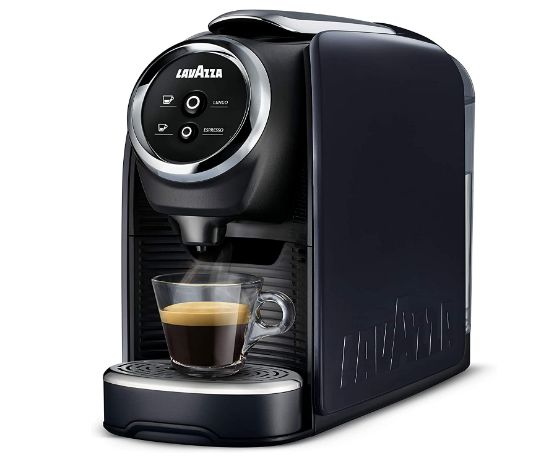
Compact Design: The Lavazza BLUE Classy Mini Single Serve Espresso Coffee Machine LB 300 has a compact design measuring 5.3″ x 13″ x 10.2″. This allows it to fit perfectly on any kitchen countertop, providing easy access for making espresso with the touch of a button.
Home Roasting Tips
1. Pay Attention to the Beans: The first step in home roasting is to choose the right type of coffee beans. Look for high-quality beans that are fresh and free from defects.
You should also consider the roast level you prefer, as different types of beans work best for different levels of roasting.
2. Selecting Your Roast Method: There are several methods to roast your coffee at home, including using a popcorn popper or a dedicated coffee roaster machine.
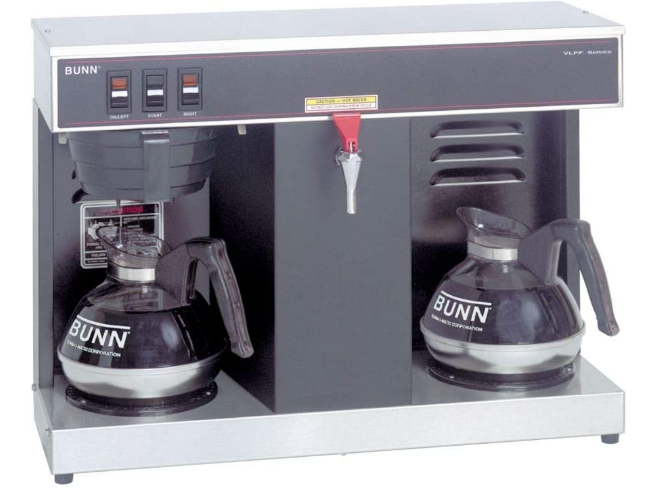
High-Quality Coffee Maker: The BUNN VLPF is a high-quality commercial coffee maker that is designed to provide exceptional performance. With a stainless steel construction and two warmers, this reliable machine is built to last and is perfect for any business setting.
Each method has its pros and cons, so it’s important to research and experiment with different techniques until you find one that works best for you.
3. Roasting Process: Once you have selected your method, it’s time to start the roasting process.
Start by preheating your equipment and then add the green coffee beans into the machine or popper.
Monitor them carefully as they will go through various stages such as yellowing, cracking, and finally reaching your desired roast level.
By following these simple tips, you will be able to enjoy freshly roasted coffee at home whenever you want it!
Home roasting can be an enjoyable experience that allows you to experiment with different flavors and techniques until you find what works best for your taste buds – plus it saves money on buying pre-roasted coffee!
Unlocking the Art of Coffee Roasting
Coffee roasting is an art that takes skill and practice to perfect.
The process involves transforming green coffee beans into the aromatic, flavorful, and rich brown beans we all know and love.
There are several methods of roasting coffee, including air roasting, drum roasting, and fluid bed roasting.
Each technique offers a unique flavor profile that affects the final taste of the coffee.
One of the most critical factors in coffee roasting is timing. Roasters must ensure they don’t under or over-roast their beans as it can significantly affect the quality of the brew.
Besides timing, temperature control is essential in bringing out specific flavors in different types of coffee.
Finally, storage plays a crucial role in ensuring roasted coffee retains its flavor for an extended period.
Once roasted, coffee should be stored away from light and oxygen to keep it fresh for as long as possible.
Overall, unlocking the art of coffee roasting requires patience, attention to detail, and a passion for great-tasting coffee.
Exploring Different Coffee Roast Profiles
The process of roasting coffee beans is a crucial step in determining the flavor and aroma of your morning cup of joe.
There are different roast profiles that you can choose from, depending on your preference.
Light roast, for example, is perfect if you’re looking for a bright and acidic taste with subtle hints of fruitiness.
Medium roast is more well-rounded and balanced with a slightly sweeter taste than light roast.
If you prefer a bolder flavor with darker notes, then dark roast might be the perfect fit for you.
This type of roast is characterized by its bold smokiness and low acidity level. You’ll also find hints of chocolate or nuttiness in this type of coffee.
One thing to keep in mind when exploring different coffee roasts is that each one requires specific brewing methods to bring out its unique flavors properly.
For instance, light roasts are best brewed using pour-over or drip methods while espresso machines work well with medium and dark roasts due to their full-bodied nature.
Experimenting with different brew methods can yield some fantastic results; it’s all about finding what works best for your personal preference!
Crafting Tasty Home-Roasted Coffee
Home-roasting coffee is a craft that offers you the opportunity to enjoy fresh, flavorful coffee in the comfort of your home.
Before jumping into roasting, it’s important to understand what you’re working with.
Coffee is made up of complex chemical compounds that provide unique flavors and aromas, and these compounds can be manipulated during the roasting process.
The degree to which coffee beans are roasted affects their flavor profile. Lighter roasts retain more of their acidity and fruitiness, while darker roasts develop a bolder, smokier taste.
When roasting at home, you’ll have control over how long you roast your beans, allowing you to experiment with different levels of roast until you find your perfect cup.
To get started with home-roasting your own coffee beans, all that’s needed is a few simple tools: green coffee beans (which can be purchased online or from specialty shops), an oven or stovetop popcorn maker for roasting (or a specialized home coffee roaster), and some basic knowledge on how to roast properly without damaging the oils in the bean.
With these tools under your belt and some experimentation time set aside each week, soon enough delicious homemade java will be yours!
Discovering Different Roast Profiles
The roast profile of a coffee bean is one of the most important factors that contribute to the final flavor and aroma of your cup.
Different roast profiles bring out different notes in a coffee’s taste, ranging from fruity and floral to nutty and chocolatey.
There are three main types of roast profiles: light, medium, and dark.
A light roast is characterized by its light brown color and mild acidity. This roast profile preserves the natural flavors of the coffee beans while adding a subtle sweetness.
Medium roasts are slightly darker in color than light roasts, with a more balanced acidity level. The flavor notes become more complex with hints of caramel or chocolate being introduced.
On the other end of the spectrum is dark roasts, which create a rich body with bold flavors such as smokiness or bitterness.
These are often used for espresso due to their strong flavor profile that can cut through milk-based drinks.
It’s important to note that each type of coffee bean will react differently depending on how it’s roasted, so experimenting with different roast profiles will help you discover your preferred taste preferences.
Beans Vs Burners: Choosing Your Roaster
When it comes to coffee, the roasting process is one of the most important factors in determining its flavor profile.
But with so many different types of roasters on the market, how do you choose the right one for your needs?
First, consider your budget. While you can find roasters at a variety of price points, keep in mind that higher-end models may offer more precision and consistency.
Next, think about your preferred roast level. Some roasters are better suited for light or medium roasts, while others excel at producing dark or espresso-style roasts.
Finally, consider the size of your operation. If you’re just brewing coffee for yourself or a small group of people, a smaller home roaster may be sufficient.
But if you’re looking to produce large quantities of coffee on a regular basis, a commercial-grade burner may be necessary to meet demand.
What is the difference between Arabica and Robusta coffee beans?
Arabica and Robusta are the two most commonly grown coffee species in the world.
Arabica beans are known for their delicate, complex flavors with notes of chocolate, fruit, and nuts.
They also contain less caffeine than Robusta beans, making them a popular choice among coffee connoisseurs who prefer a milder taste profile.
On the other hand, Robusta beans are cheaper to produce because they are more resistant to pests and diseases.
They have a stronger and more bitter taste with earthy undertones and higher caffeine content.
This makes them suitable for use in espresso blends since they can cut through milk-based drinks better than Arabica.
It is essential to note that not all coffee beans within the same species will have similar flavor profiles as different factors such as soil type, altitude, and climate conditions affect how each bean tastes; however, understanding the difference between Arabica and Robusta can help you make an informed choice when selecting your preferred roast or blend.
How is coffee roasted?
The process of roasting coffee is an essential step in bringing out the unique flavors and aromas that we all love.
Roasting coffee beans involves heating them at high temperatures, causing chemical reactions to occur within the beans.
The degree of heat and duration of roasting will significantly influence the flavor profile of the final cup of coffee.
The roasting process begins with selecting quality green coffee beans from various regions worldwide.
These raw beans are then placed into a large drum roaster, which circulates hot air around them while constantly rotating to ensure an even roast.
During this process, the natural sugars and oils within the beans begin to caramelize, producing complex flavors such as chocolate, nutty or fruity notes.
Finally, after reaching a specific temperature determined by the desired roast level (light, medium or dark), they are removed from the roaster and rapidly cooled to prevent any further cooking.
This cooling stage is crucial as it locks in those delicious aromas freshly roasted coffee lovers crave.
Overall, understanding how each roast affects taste will help you choose what type of bean is best for your palate when ordering your next cup at your local café or brewing your own perfect pot at home!
What are the benefits of coffee roasting?
Coffee roasting is the process of heating green coffee beans to transform them into the rich, aromatic brown beans we know and love.
Not only does this enhance their flavor, but it also offers several benefits.
Firstly, coffee roasting enhances the taste and aroma of coffee.
The heat produces chemical reactions that create hundreds of compounds that give the beverage its rich flavor profile.
Roasting also caramelizes the natural sugars in coffee beans, giving them a sweet and savory taste.
Secondly, roasted coffee has a longer shelf life than unroasted green beans because it destroys harmful bacteria that can cause spoilage.
The roasting process reduces moisture content in coffee beans making them less vulnerable to mold or insect infestations.
Finally, roasted coffee contains antioxidants and nutrients such as magnesium and potassium which offer numerous health benefits including reducing inflammation, improving heart health, and preventing some chronic diseases such as diabetes type
In conclusion, by enhancing flavor profiles while increasing shelf life and providing vital nutritional value for a healthy lifestyle; there are many benefits to be gained from roasting your own fresh-brewed cup of joe!

Quick and Easy Cooking: The Instant Vortex Plus 10-Quart Air Fryer is designed for quick and easy cooking, making meals in a fraction of the time. With seven preset functions, you can easily prepare foods like fries, chicken wings, nuggets, steak, and more with just one press of a button.
What is the difference between Arabica and Robusta coffee?
Arabica and Robusta are the two most popular types of coffee beans in the world.
Arabica is known for its smooth, delicate flavor and lower caffeine content.
It is grown at higher altitudes and takes longer to mature, resulting in a more complex taste profile.
In contrast, Robusta coffee has a stronger, more bitter taste with twice the caffeine of Arabica. It is easier to cultivate and grows at lower elevations.
When it comes to roasting, Arabica beans tend to roast better due to their denser structure.
They also require less heat and time than Robusta beans because they contain less moisture.
On the other hand, Robusta beans can withstand high heat without losing their flavor or body.
So which one should you choose? It ultimately depends on your personal preference. If you prefer a smoother taste with less caffeine, go for Arabica coffee.
If you want a stronger kick with a bitter aftertaste, opt for Robusta coffee instead.
What is the difference between French Press and Coffee Press?
French press and coffee press are two terms that are often used interchangeably but they actually refer to two different things.
A French press is a type of coffee maker that utilizes a plunger and mesh filter to brew coffee while a coffee press refers to any device or method used to make coffee without electricity, such as manual pour-over drippers or percolators.
When it comes to the brewing process, the main difference between the French press and other methods is that with the French press, the coffee steeps in water for several minutes before being filtered while manual pour-over drippers allow hot water to flow through the grounds quickly.
This results in a fuller-bodied cup of coffee with more oils and sediment than other methods.
It’s worth noting that both the French press and other manual brewing methods require freshly roasted beans to ensure optimal flavor.
When roasting your own beans, be sure to pay attention to factors like heat level, time duration, bean variety, and quality as these can all impact flavor profile.
Ultimately, whether you prefer the French press or another method will come down to personal preference in terms of taste, convenience, and ease of use.
What is the difference between Single Origin and Blended Coffee?
Single-origin and blended coffee are two different types of coffee that you can find in coffee shops or supermarkets.
Single-origin coffees come from a specific farm, region, or country, and the beans are grown under similar soil, weather conditions, and altitude.
The distinct flavor profile of single-origin coffee is influenced by the unique characteristics of its origin.
These coffees have a higher price point due to their limited availability and shorter shelf life.
On the other hand, blended coffee is a mixture of two or more types of beans from different origins.
Blending allows roasters to create consistent flavor profiles year-round by balancing out certain flavors or adding complexity to the cup.
Blended coffees are often chosen for espresso-based drinks like lattes because they provide a strong body with a rich crema.
In conclusion, both single-origin and blended coffees have their own unique taste characteristics that cater to different preferences.
Some people might prefer single-origin for its distinct flavors while others may opt for blended coffee for its consistency in taste all year round.
Regardless of your preference, it’s important to know what goes into your cup to appreciate the artistry behind each roast.
Coffee roasting process step-by-step
Firstly, the coffee roasting process starts with selecting the right quality of beans.
The green coffee beans are carefully selected based on various factors like origin, altitude, and moisture content.
Once the beans are chosen, they are cleaned to remove any impurities or foreign objects.
Next, the beans are preheated to ensure even roasting. This is done by placing them in a rotating drum that is heated to around 200-220 °C.
As the temperature increases, the beans start to release moisture and undergo chemical reactions that create complex flavors and aromas.
After a few minutes of preheating, it’s time for the actual roasting process.
The heat is increased to around 230-240 °C as the beans continue to rotate.
This stage is where most of the flavor development occurs as sugars caramelize and acids break down into more palatable compounds.
During this time, it’s crucial for a skilled roaster to monitor color changes in each batch closely since it indicates how far along they are in developing optimal flavors.
When the desired roast level is achieved (light medium/medium/dark), heat is reduced immediately through a cooling mechanism so that beans stop cooking right away rather than continuing their internal heating.
Types of coffee roasting machines
One of the most important factors in determining the flavor and quality of coffee is the roasting process.
The type of roasting machine used can also have an impact on this process.
There are three main types of coffee roasting machines: drum, fluid bed, and hot air.
Drum roasters are the most common type and work by rotating a drum over a heat source. The beans are constantly stirred to ensure even roasting.
These machines can handle larger batches of beans but require more time to cool down between batches.
Fluid bed roasters use hot air to roast the beans as they float on a cushion of air.
This method produces a cleaner-tasting coffee with less smoke but requires regular cleaning due to chaff buildup.
Hot air roasters operate similarly to fluid bed roasters but use a different technique for heating the air.
They produce consistent results and do not require any additional cooling time between batches but are typically more expensive than other types of machines.
Coffee roasting temperature and time
The temperature and time of coffee roasting are critical factors that affect the flavor, aroma, and color of the final product.
The roasting process begins when green coffee beans are heated to a specific temperature and roasted for a certain time.
During this process, the beans undergo physical and chemical changes that transform them from green to brown.
The ideal temperature and time for coffee roasting depend on various factors such as bean type, roast level desired, moisture content, and altitude at which it was grown, among others.
A roast profile typically involves three phases: the drying phase (up to 165°C), the browning phase (165-200°C), and the development phase (200-240°C).
Roasters have different preferences when it comes to these phases; some prefer a shorter drying phase with higher heat while others opt for longer times at lower temperatures.
In summary, understanding how coffee roasting temperature and time work together is crucial in achieving the desired flavor profile.
It takes skillful attention to detail during the entire process – from selecting high-quality beans to determining optimal conditions for heating – in order to create an unforgettable cup of coffee.
How to roast coffee beans with flavor
Roasting coffee beans is an art that requires knowledge, skills, and patience.
The process involves bringing out the natural flavors of the coffee beans by applying heat gradually until they turn brown.
To roast coffee beans with flavor, you need to consider various factors such as bean origin, roasting method, and temperature.
Firstly, you have to choose high-quality coffee beans that are rich in flavor and aroma.
You can opt for single-origin or blended coffee beans depending on your preference.
Secondly, select a suitable roasting method such as drum roasting or fluid bed roasting based on your expertise and equipment availability.
The next step is determining the optimal temperature for roasting the coffee beans to perfection.
Roasting at higher temperatures will result in darker roasted coffee with a bold flavor while lower temperatures will produce a lighter roast with subtle flavors.
Finally, you need to pay attention to the cooling process after roasting as it affects the final taste of your coffee.
Ensuring proper cooling will help lock in the flavors and aromas of your freshly roasted coffee beans.
Conclusion
In conclusion, coffee roasting is a complex process that requires a lot of attention to detail.
The roast level greatly affects the taste and aroma of the coffee, so it’s important to choose the right one for your preferences.
Additionally, there are different methods of roasting coffee, each with its own advantages and disadvantages.
If you’re interested in experimenting with coffee roasting at home, make sure you have the right equipment and follow safety precautions.
Roasting coffee can produce smoke and chaff that can be dangerous if not handled properly.
You’ll also need to source high-quality green beans from reputable suppliers.
Overall, understanding the basics of coffee roasting can help you appreciate your cup of joe even more.
Whether you prefer a light or dark roast, single origin, or blend, knowing how your coffee was roasted can enhance your overall experience.

